Check in at Heathrow two -three hours prior to departure for your overnight flight (non stop) to Colombo.
On arrival at Colombo airport you will be met and transferred to your first stop in the Cultural Triangle. Your driver guide will remain with you until you arrive at the beach. The journey is approximately 4 hours.
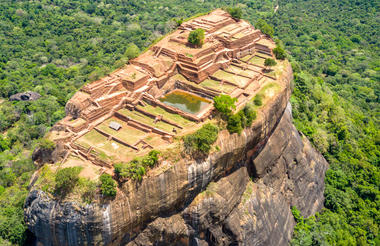
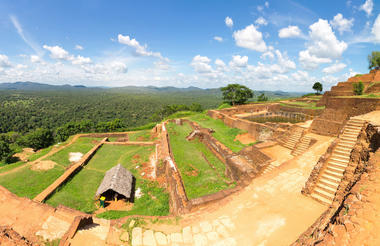
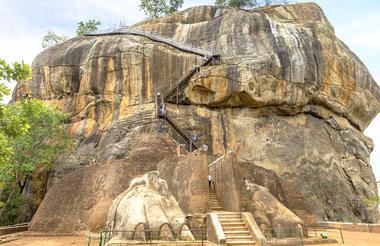
Morning at lesiure. Depart early afternoon for the national park.
Minneriya National Park
The Minneriya Tank was created by King Parakarambahu at the height of Polonnaruwa’s glory as the capital of Sri Lanka. The national park based largely around the huge tank (reservoir) was created rather more recently but serves as an important gathering place for Sri Lanka’s large population of elephants. It is a great place for elephant spotting all year round – though as the dry season makes water scarce between June and September, more and more elephants gather on the shores of Minneriya Tank.
Indeed by late August and September, the awe inspiring site of up to 300 elephants can often be seen, in a phenomenon known as ‘The Gathering’. It is the largest concentration and gathering of Asian elephants that can be seen anywhere in the world. Watching baby elephants playing with each other, bull elephants tussling for dominance and the great matriarchs surveying the scene is not a sight you are likely to forget in a hurry. Aside from the elephant, Minneriya is also home to some 23 other species of mammals: some, like the Deer and Sambur you will see, some like the Leopard and the Sloth Bear will probably prove elusive. The arid dry zone is a paradise for many species of Lizard and you will see them here in all their technical colour brilliance if you look carefully enough, as well as snakes like the Indian Python and the Mugger Crocodile. Above all, of course, are Sri Lanka’s wonderfully varied bird population. Among the 150 or so species, particular favorites of ours you may see in Minneriya include the beautiful painted stork, and various other bird species.

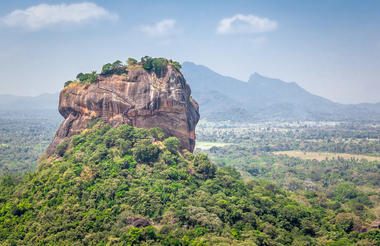
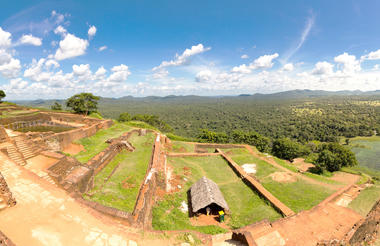
Afternoon
We suggest an early visit to the Sigiriya Rock Fortress. Late morning we could suggest an optional excusrion for a local village experience.
Sigiriya Rock Fortress
This is one of the most amazing historical sites of Sri Lanka and a must visit. However, take heed, the climb to the top (about 1200 steps)takes about 1-1/2 hours. Not suitable for those who are unfit or cannot deal with heights. Take a moment to read our expert tips.
Sigiriya (Lion Rock) Referred by locals as the Eighth Wonder of the World this ancient palace and fortress complex has significant archaeological importance and attracts thousands of tourists every year. It is probably the most visited tourist destination of Sri Lanka. Sigiriya rock plateau, formed from magma of an extinct volcano, is 200 meters higher than the surrounding jungles. Its view astonishes the visitors with the unique harmony between the nature and human imagination. The fortress complex includes remnants of a ruined palace, surrounded by an extensive network of fortifications, vast gardens, ponds, canals, alleys and fountains. In the 3th century BC the rocky plateau of Sigiriya served as a monastery. In the second half of the 5th century King Kasyapa decided to construct a royal residence here. After his death Sigiriya again became a Buddhist monastery until the 14th century, when it was abandoned. The main entrance is located in the northern side of the rock. It was designed in the form of a huge stone lion, whose feet have survived up to today but the upper parts of the body were destroyed. The western wall of Sigiriya was almost entirely covered by frescoes, created during the reign of Kasyapa. Eighteen frescoes have survived to this day. The frescoes are depicting nude females and are considered to be either the portraits of Kasyapa’s wives and concubines or priestess performing religious rituals. One of the most striking features of Sigiriya is its Mirror wall.
For those who are not comfortable with heights or have problems climbing we suggest the gardens of Sigiriya which are amongst the oldest landscaped gardens in the world. They are located in the western part of the rock with bridges, fountains, as well as surface and underground water pumps.
Hiriwaduna Village Walk - Optional excursion at extra cost
The tour starts off with a ride on a Bullock cart (ox cart) along a dirt track and through rice paddies down to the picturesque Hiriwaduna Lake. The adventure continues with a catamaran ride on the scenic Hiriwaduna Lake with its large variety of dry zone bird life and views of the surrounding forest, marshland and vegetable plots of local farmers.
After the catamaran ride you will take a short ride on a walking tractor or on the famous „Tuk Tuk‟ to a local home where you can interact with the family by assisting the women in the preparation of a Sri Lankan lunch using the tradi- tional Sri Lankan methods of cooking. After enjoying the lunch you helped to prepare you will take a leisurely 150 metre walk back to the main road.



Tips on climbing Sigriya.
Avoid the crowds and humidity and be the first to climb. The time for opening may vary but do try to arrive early and be the first to enter.
Go at your pace and take plenty of water with you. Due to the steepness and the humidity it is a very strenuous climb. The first few stairways are relatively unchallenging. The fountain gardens and the Boulder gardens but don't spend too long here. They are worth a visit and you can visit after your climb down but you must stay ahead of the crowds.
The first stop is the mirror wall accessed via and the mirror stair case. The next point of interest is the frescoes. You may be tempted to skip this but don't! The narrow steep staircase is worth climbing. You won't be disappointed.
Keep going. The summit at the top where the palace was located and the views are spectacular.
Avoid the monkeys and the hornets, Bring lots of water - there are no shops enroute.
Afternoon
Today you will be traveling to Pasikudah and making some stops enroute. The journey time excluding stops is 3 hours. Once you reach your beach hotel, your guide and vehicle will not be available. You will have the next few days to enjoy the beach.
Polonnaruwa was the 2nd capital city of Sri Lanka, built in the 11th and 12th centuries AD, and which is also a World Heritage Site. Within the ruins of the Royal Palace, the Gal Viharaya, there are four splendid statues of the Buddha in 'Upright', 'Sedentary' and 'Recumbent' postures carved out of rock. In addition, the remains of stunning buildings including the Audience Hall, the Lotus Bath, king Parakramabahu's statue, and the Parakrama Samudraya lake built by King Parakramabahu the great, provide an insight into this great historic city. Polonnaruwa is also home to monuments of famous places of worship including the Shiva Temple, the Lankathilake, the Watadage, the Galpotha, the Kiri Vehera and the remains of a former Temple of the Tooth Relic, now found in Kandy. Approximately a one hour drive from Sigiriya, we recommend most clients visit Polonnaruwa in conjunction with Sigiriya during a stay in the Cultural Triangle. Visiting Polonnaruwa in the morning combines well with an afternoon Jeep Safari from Harbarana, in one the close-by national parks to see wild elephant and the vast array of local wildlife.
At a small addtional cost we can offer you the opportunity to explore Polonnaruwa by bike.
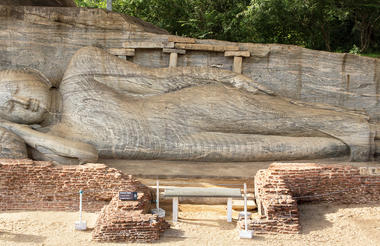


Today a guide will rejoin you - it may not be the same driver and guide. You will be traveling to Rosyth Estate House- the next stop on your adventure. To avoid one long journey we suggest that you make a stop at a historical site which will break up the long 5 hour journey today.
Visit the Dambulla Rock Temple, which was donated by king Walagambahu in the 1st century BC to Buddhist monks. Dambulla is a World Heritage Site and is the most impressive of Sri Lanka's cave temples. The complex of five caves with over 2000 sq. meters of painted walls and the ceiling is the largest area of cave paintings found in the world. These caves contain over 1500 images of the Buddha of which the largest is the colossal figure of the Buddha carved out of rock spanning 14 meters. Close to the town of Dambulla this attraction is easily accessed although it requires walking up a considerable number of steps to reach the caves from the road. If you are a little short of time, a visit to the Dambulla rock temple can be combined with travelling to or from the Sigiriya area.



Morning
This morning we suggest a trip to the ancient city of Kady and a train journey on route.
Train from Rambukana to Kandy
The train journey is on the bucket list of most travellers to Sri Lanka. Why is the Kandy to Ella train journey so amazing? The views on both sides of the rail are breathtaking but it is a journey on one of the most charmingly decrepit railway systems in the world which reinforces the desire to travel in a modicum of discomfort!
If you are not traveling to the High tea country, this hsort journey gives you an opportunity to experience the trains. At Rambukkana, the line begins a steep climb into the hills. From Rambukana to Kandy, at Kadugannawa the track runs along the edge of sheer cliffs, allowing passengers a view of Batalegala (Bible Rock). Your guide will drop you at the station and wait until you have boarded the before driving to meet you in Kandy. The train for this portion may be quicker than the drive.
Kandy was the last capital of the Sri Lankan kings, and is a World Heritage Site. The name Kandy conjures visions of splendour and magnificence. Many of the legends, traditions and folklore are still lovingly kept alive. Drive around the Kandy Lake built by the last Sinhala king Sri Wickrama Rajasinghe in 1798.
In 1542 the Tooth Relic was brought to the city , stimulating a flurry of new religious building- a two storey for the relic itself and 86 houses for the monks. By 1602 the city had probably taken the form. Kandy was repeatedly attacked by the Portuguese, Dutch and the British and been rebuilt several times.
The area with the Temple of the Tooth and associated buildings, a world heritage site, is the chief focus of interest. The Udmale (upper storey) houses the relic which is caged behind gilded iron bars and a series of 7 seven smaller caskets. Ceremonies start at 0530, 0930 and 1830. These are moment the temple comes to life with pilgrims. One would need to be dressed appropriately for the temple as any other religious building. Kandy is perhaps most famous however for the annual Perahara, a most magnificent site which sees the scared tooth relic take to the streets accompanied by dancers, drummers and most significantly elephants dressed in all their finery and adorned with lights. The parade which goes through the streets of Kandy builds into a spectacular procession over consecutive nights with the number of elephants growing each night. The procession normally takes place annually at the end of July or early August.
Peradeniya Royal Botanical Gardens
This botanical garden was first built as a pleasure garden by a Sinhala king and was expanded by the British during the period of colonial rule. Royal Botanical Garden, Peradeniya (5.5 km west of Kandy) is renowned for its collection of a variety of orchids and includes more than 4000 species of plants, including of orchids, spices, medicinal plants and palm trees.The Botanic Gardens crested in 1371 when King Wickramabahu III kept court at Peradeniya near Mahaweli river. This was followed by King Kirti Sri and King Rajadhi Rajasinghe. A temple was built on this location by King Wimala Dharma, but it was destroyed by the British when they were given control over the Kingdom of Kandy. Alexandar Moon then created the botanical gardens in 1821. The Botanical Garden at Peradeniya was formally established in 1843 with plants brought from Kew Garden, Slave Island, Colombo, and the Kalutara Garden in Kalutara.
The classical Avenue of Palms is located in this Garden. One tree with a significant history is the Cannonball Tree planted by King George V of the United Kingdom and Queen Mary in 1901. During the Second World War, the Botanical Garden was used by Lord Louis Mountbatten, the supreme commander of the allied forces in the South Asia, as the headquarters of the South East Asia Command.



Rosyth Sri Lankan Cooking Class - Optional at extra cost.
After a relaxed breakfast, at approximately 10:30 visit the organic kitchen garden with the Chef who, along with the gardener will explain the produce and some of the spices that is grown at Rosyth. On your return to the kitchen, you will have the opportunity to cook authentic Sri Lankan curries. You may be joined by other guests. The maximum number of guests is eight. The menu has been designed to include ingredients which are available in Europe. Your hands-on cooking class will include a fish or chicken curry and three other vegetable curries and a traditional salad. Sit down for lunch in the dining room in the canopy of the trees with the curries that you have cooked and enjoy your lunch with the rice and poppadum's. You will have the opportunity to take away the recipes to replicate at home. The curries: The main curries are Chicken, Fish or Mushroom. Green bean, Lentil and spinach, aubergine & Gotkola sambal. When you sit for lunch we will serve you red or white rice, popadoms and homemade chutneys. You will have the recipes to take home and we suggest you purchase the spices from a supermarket before you fly home.
Rosyth Artisanal Tea
Rosyth Estate House has begun a journey to become an organic, artisanal producer of Sri Lankan tea. Removing mechanisation from the processes they have started to produce hand rolled tea which is carefully crafted on the estate by our local artisans. This project is wholeheartedly community focused as we look to improve the economic sustainability of our valley.
Depending on the time you have and your interest, please feel free to dip in and experience the different aspects of becoming an artisanal tea maker.
Join the ladies in our tea gardens which are spread around the estate. They start early (about 6am) but you might want to start a bit later. They will teach you the art of plucking; just buds or two leaves and a bud. Just buds - "golden tips" or "silver tips," tea tips are the small, unopened leaves of the tea plant are the sweetest part of the tea leaf. This is a great chance to interact with our local community and also understand the challenges that the ladies have in picking the freshest leaves. You will be unlikely to grab a tea bag again.
If you are interested in learning how artisan tea is made, you will have the opportunity to hand roll the leaves, return to watch the next process where the tea is fermented and then dried . End with tasting the different teas that they produce,
Rosyth Estate Walk
Rosyth is a small working estate. Tea is plucked by hand and sold to the nearby tea factory, whilst latex is tapped, treated and sold to a local rubber factory. Coconuts, fruits, spices and other produce are grown on the estate and are, wherever possible, used as part of our menus.
Guests are free to explore the estate, join the ladies plucking two leaves and a bud from the tea bushes or see how the rubber is tapped. Equally take a walk down to the river and discover the small waterfall or to the local paddy fields and enjoy meeting with the local villagers. The Estate contains walking trails, mountain biking routes and our staff will be happy to guide you through the tea terraces, rubber plantation and paddy fields.



Morning
Cooking lesson
Afternoon
Rosyth Artisinal Tea
Afternoon
Estate Walk
The end of your itinerary. Your driver guide will reconfirm the pick up time. The journey to the airport is approximately 2 hours and your guide will aim to get you to the airport 3 hours prior to your departure time.




